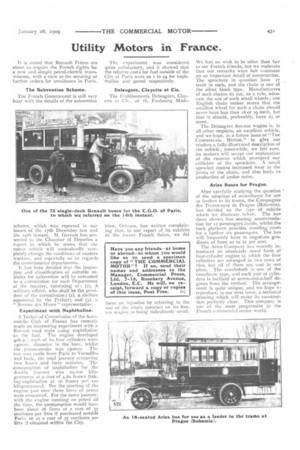Utility Motors in France.
Page 13

If you've noticed an error in this article please click here to report it so we can fix it.
It is stated that Renault Freres are about to acquire the French rights for a new and simple petrol-electric transmission, with a view to the securing of further orders for omnibuses in Paris.
The Subvention Scheme.
The French Government is still very busy with the details of the subvention scheme, which was reported in our issues of the 17th December last and the r4th instant. M. Gervais has presented to the Chamber of Deputies a report in which he states that • the motor vehicle will undoubtedly completely change the conditions of modern warfare, and especially so as regards the commissariat departments.
It has been decided that the inspection and classification of suitable vehicles for subvention will be entrusted to a commission for each Department of the country, consisting of : (I), A military officer, who shall be the president of the commission ; (2), a civilian appointed by the Prefect; and (3), a " Service des Mines " representative.
Experiment with Naphthaline.
A Technical Commission of the Automobile Club of France has recently made an interesting experiment with a Renard road train using naphthaline as the fuel. The engine developed 4oh.p.; each of its four cylinders were r4omrn. diameter in the bore, whilst the piston-stroke was isomm. The run was made from Paris to Versailles and back, the total journey occupying two hours and forty minutes. The consumption of naphthaline for the double journey was 29.200 kilogrammes at a cost of 4.60 francs (taking naphthaline at 16 francs per too kilogrammes). For the startinv of the engine just over three litres of petrol were consumed. For the same journey, with the engine running on petrol all the time, the consumption would have been about 26 litres at a cost of 37 centimes per litre if purchased outside Paris, or at a cost of 57 centimes per litre if obtained within the City.
The experiment was considered quite satisfactory, and it showed that the relative costs for fuel outside of the City of Paris were as i to 24 for naphthaline and petrol respectively.
Delaugere, Clayette et Cie. The Etablissments Delaugere, Clayette et Cie., of 16, Faubourg Made leine, Orleans, has written complaining that, in our report of its exhibits at the recent French Salon, we did
them an injustice by _referring to the size of the chain sprocket on its fiveton wagon as being ridiculously small. We had no wish to be other than fair to our French friends, but we maintain that our remarks were fair comment on an important detail of construction. The sprockets in question have 17 teeth in each, and the chain is one of the silent block type. Manufacturers of such chains do not, as a rule, advocate the use of such sr-nail wheels; one English chain maker states that the smallest wheel for such a chain should never have less than 18 or Pa teeth, but that it should, preferably, have 23 or more.
The Delaugere five-ton wagon is, in all other respects, an excellent vehicle, and we hope, in a future issue of "THE: COMMERCIAL MOTOR," to 'give our readers a fully-illustrated description of the vehicle; meanwhile, we feel sure, its makers will accept our explanation of the reasons which prompted our criticism of the sprockets. A small sprocket means increased wear in the joints of the chain, and also leads to production of undue noise.
Aries Buses for Prague.
After carefully studying the question of the adoption of motorbuses for use as feeders to its trams, the Compagnie des Tramwayes de Prague (Bohemia), has decided on the type of vehicle which we illustrate below. The bus there shown has seating aocommodation for 12 passengers inside, whilst the back platform provides standing room for a further six passengers. The bus will frequently have to negotiate gradients of from 20 to 22 per cent. The Aries Company has recently introduced an absolutely novel form of four-cylinder engine in which the four cylinders are arranged in two rows of two, but all of them are cast in one piece. The crankshaft is one of the two-throw type, and each pair of cylinders is inclined at seven-and-a-half degrees from the vertical. The arrangeinent is quite unique, and we hope to reproduce, in our next issue, a sectional drawing which will make its construction perfectly clear. This company is one of the most progressive in the French commercial-motor world.




















